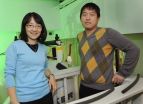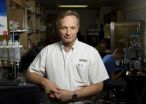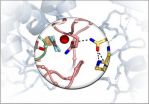(Press-News.org) The Terminator. The Borg. The Six Million Dollar Man. Science fiction is ripe with biological beings armed with artificial capabilities. In reality, however, the clunky connections between living and non-living worlds often lack a clear channel for communication. Now, scientists with the Lawrence Berkeley National Laboratory (Berkeley Lab) have designed an electrical link to living cells engineered to shuttle electrons across a cell's membrane to an external acceptor along a well-defined path. This direct channel could yield cells that can read and respond to electronic signals, electronics capable of self-replication and repair, or efficiently transfer sunlight into electricity.
"Melding the living and non-living worlds is a canonical image in science fiction," said Caroline Ajo-Franklin, a staff scientist in the Biological Nanostructures Facility at Berkeley Lab's Molecular Foundry. "However, in most attempts to interface living and non-living systems, you poke cells with a sharp hard object, and the cells respond in a predictable way – they die. Yet, in Nature many organisms have evolved to interact with the rocks and minerals that are part of their environment. Here, we took inspiration from Nature's approach and actually grew the connections out of the cell."
Coaxing electrons across a cellular membrane is not trivial: attempts to pull an electron from a cell may disrupt its function, or kill the entire cell in the process. What's more, current techniques to transfer cellular electrons to an external source lack a molecular roadmap, which means even if electrons do turn up outside a cell, there is no way to direct their behavior, see where they stopped along the way, or send a signal back to the cell's interior.
"We were interested in finding a pathway that wouldn't kill the living systems we were studying," said Heather Jensen, a graduate student at University of California, Berkeley whose thesis work is part of this publication. "By using a living system in electronics, we can one day create biotechnologies that can repair and self-replicate."
In their approach, Jensen, Ajo-Franklin and colleagues first cloned a part of the extracellular electron transfer chain of Shewanella oneidensis MR-1, marine and soil bacteria capable of reducing heavy metals in oxygen-free environments.
This chain or "genetic cassette," Ajo-Franklin notes, is essentially a stretch of DNA that contains the instructions for making the electron conduit. Additionally, because all life as we know it uses DNA, the genetic cassette can be plugged into any organism. The team showed this natural electron pathway could be popped into a (harmless) strain of E. coli—a versatile model bacteria in biotechnology— to precisely channel electrons inside a living cell to an inorganic mineral: iron oxide, also known as rust.
Bacteria in environments without oxygen, such as Shewanella, use iron oxide from their surroundings to breathe. As a result, these bacteria have evolved mechanisms for direct charge transfer to inorganic minerals found deep in the sea or soil. The Berkeley Labs team showed their engineered E. coli could efficiently reduce iron and iron oxide nanoparticles—the latter five times faster than E. coli alone.
"This recent breakthrough is part of a larger Department of Energy project on domesticating life at the cellular and molecular level. By directly interfacing synthetic devices with living organisms, we can harness the vast capabilities of life in photo- and chemical energy conversion, chemical synthesis, and self-assembly and repair," said Jay Groves, a faculty scientist at Berkeley Labs and professor of chemistry at University of California, Berkeley. "Cells have sophisticated ways of transferring electrons and electrical energy. However, just sticking an electrode into a cell is about as ineffective as sticking your finger into an electrical outlet when you are hungry. Instead, our strategy is based on tapping directly into the molecular electron transport chain used by cells to efficiently capture energy."
The researchers plan to implement this genetic cassette in photosynthetic bacteria, as cellular electrons from these bacteria can be produced from sunlight—providing cheap, self-replicating solar batteries. These metal-reducing bacteria could also assist in producing pharmaceutical drugs, Ajo-Franklin adds, as the fermentation step in drug manufacturing requires energy-intensive pumping of oxygen. In contrast, these engineered bacteria breathe using rust, rather than oxygen, saving energy.
INFORMATION:
Berkeley Lab scientists open electrical link to living cells
2010-10-22
ELSE PRESS RELEASES FROM THIS DATE:
12 new epilepsy drugs usher in 'era of abundance'
2010-10-22
MAYWOOD, Ill. -- A dozen new epilepsy drugs are giving doctors and patients more options, but making treatment decisions more complex, a Loyola epilepsy specialist reports in the journal Neurologic Clinics.
"Clinicians practice in an era of abundance of anti-epileptic drugs," Dr. Jorge J. Asconapé wrote. The new drugs provide "an opportunity to better meet the needs of more patients."
Asconapé's article will appear in the November issue of Neurologic Clinics, now available online.
Since 1993, the Food and Drug Administration has approved 12 new anti-epileptic drugs: ...
New research provides insights into space weather, could benefit satellites, aircraft
2010-10-22
Settling decades of scientific debate, researchers from UCLA and the British Antarctic Survey have discovered the final link between electrons trapped in space and the glow of light from the upper atmosphere known as the diffuse aurora.
The finding will help scientists better understand space weather and how space storms affect the Earth's atmosphere from the top down, with potential benefits for the satellite, power-grid and aviation industries, the researchers said.
Their research appears Oct. 21 in the journal Nature.
Scientists have long known that the diffuse ...
Dad's weight and diet linked to offspring's risk of diabetes
2010-10-22
Medical researchers at the University of New South Wales have for the first time shown a link between a father's weight and diet at the time of conception and an increased risk of diabetes in their offspring.
The finding, reported in the prestigious journal Nature, is the first in any species to show that paternal exposure to a high-fat diet initiates progression to metabolic disease in the next generation.
"We've known for a while that overweight mums are more likely to have chubby babies, and that a woman's weight before and during pregnancy can play a role in future ...
A new way to weigh planets
2010-10-22
An international CSIRO-led team of astronomers has developed a new way to weigh the planets in our Solar System – using radio signals from the small spinning stars called pulsars."This is first time anyone has weighed entire planetary systems – planets with their moons and rings," said team leader Dr David Champion from Germany's Max-Planck-Institut für Radioastronomie.
"And we've provided an independent check on previous results, which is great for planetary science."
Measurements of planet masses made this new way could feed into data needed for future space missions.
Until ...
Towards better explosives detectors
2010-10-22
WASHINGTON, D.C., (Oct. 21, 2010) -- Over the past decade, Christine Mahoney and a team of scientists at the National Institute of Standards and Technology (NIST) in Maryland have been working to stop the threat of terrorist-based attacks in the form of explosives or explosive-based devices, by providing a sound measurement and standard infrastructure.
"Our program encompasses many different aspects of explosives research, from development of measurement standards for trace explosives detection at airports, to the development and application of new metrology for the direct ...
Simple blood test helps predict chronic kidney disease
2010-10-22
Measuring three biomarkers in a single blood sample may improve physicians' ability to identify patients at high risk of developing chronic kidney disease (CKD), according to a study appearing in an upcoming issue of the Journal of the American Society of Nephrology.
"Our results identify biomarkers that can improve CKD risk prediction," comments Caroline S. Fox, MD, MPH of the National Heart, Lung, and Blood Institute's Framingham Heart Study, Framingham, Mass.
The study included more than 2,300 participants in the Framingham Offspring Study, a long-term follow-up ...
LRO's LAMP ultraviolet spectrograph observes LCROSS blast, detects surprising gases in impact plume
2010-10-22
NASA's Lunar Reconnaissance Orbiter (LRO) and its sophisticated suite of instruments have determined that hydrogen, mercury and other volatile substances are present in permanently shaded soils on the Moon, according to a paper published today in Science.
The Lunar Crater Remote Observation and Sensing Satellite (LCROSS), which launched with LRO, was intentionally crashed onto the Moon's surface Oct. 9, 2009, while LRO instruments watched. About 90 seconds after LCROSS hit the Moon, LRO flew past the debris plume raised by the impact, while the Lyman Alpha Mapping Project ...
Iowa State, Ames Lab chemists discover proton mechanism used by flu virus to infect cells
2010-10-22
AMES, Iowa – The flu virus uses a shuttle mechanism to relay protons through a channel in a process necessary for the virus to infect a host cell, according to a research project led by Mei Hong of Iowa State University and the Ames Laboratory.
The findings are published in the Oct. 22 issue of the journal Science.
Hong, an Iowa State professor of chemistry and an associate of the U.S. Department of Energy's Ames Laboratory, said her research team used solid-state nuclear magnetic resonance (NMR) spectroscopy to determine the structure and workings of the proton channel ...
Putting a bull's-eye on the flu: Detailing influenza's structure for drug targeting
2010-10-22
Beating the flu is already tough, but it has become even harder in recent years – the influenza A virus has mutated so that two antiviral drugs don't slow it down anymore.
Reporting their findings in the journal Science, researchers from Florida State and Brigham Young move closer to understanding why not, and how future treatments can defeat the nasty bug no matter how it changes.
The two drugs, amantadine and rimantadine, are no longer recommended by the CDC for use against flu.
They used to work by blocking a hole in the influenza A virus called the "M2 channel," ...
Study details molecular structure of major cell signaling pathway
2010-10-22
(Embargoed) Scientists at the University of North Carolina at Chapel Hill School of Medicine have reported the exact molecular structure and mechanisms of a major cell signaling pathway that serves a broad range of functions in humans.
Up to half of drugs approved by the US Food and Drug Administration directly or indirectly target G protein-coupled receptors. These receptors, which are proteins that live in the outer membranes of cells, take molecular signals from outside the cell and convert them into responses within – and those responses help control behaviors as ...




